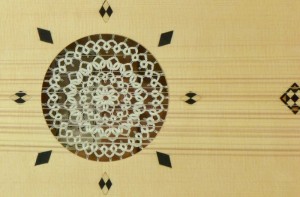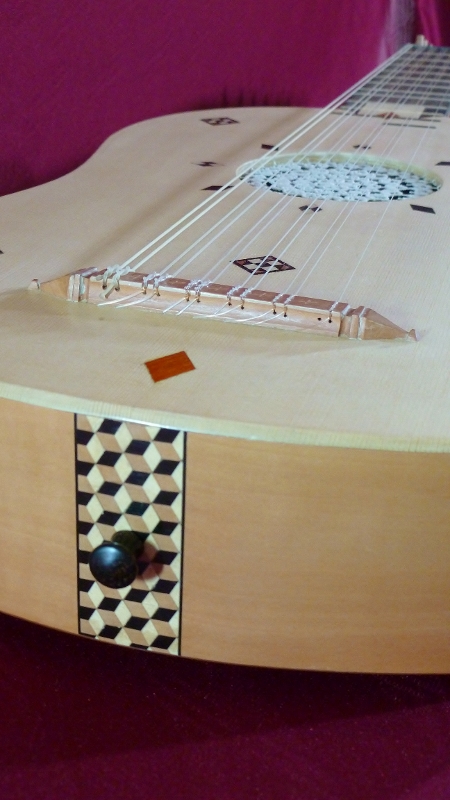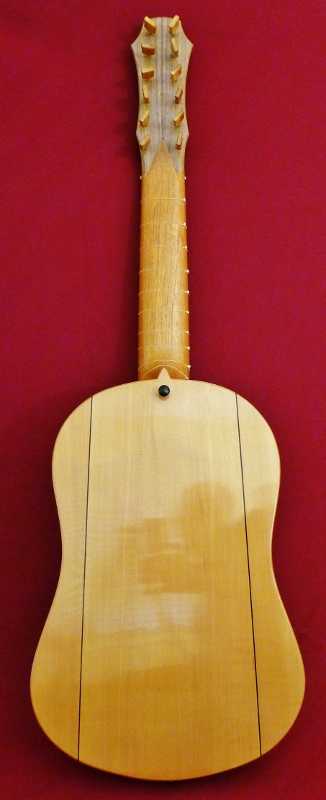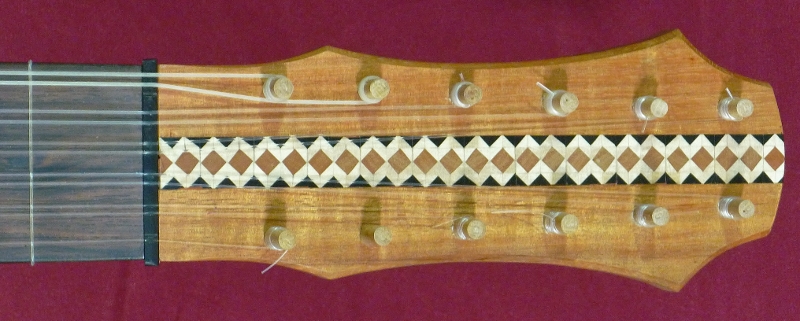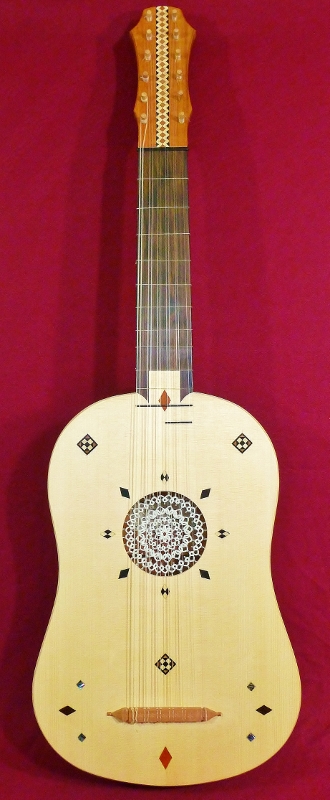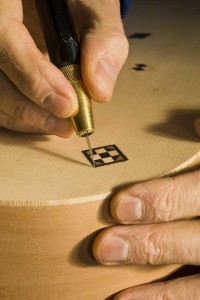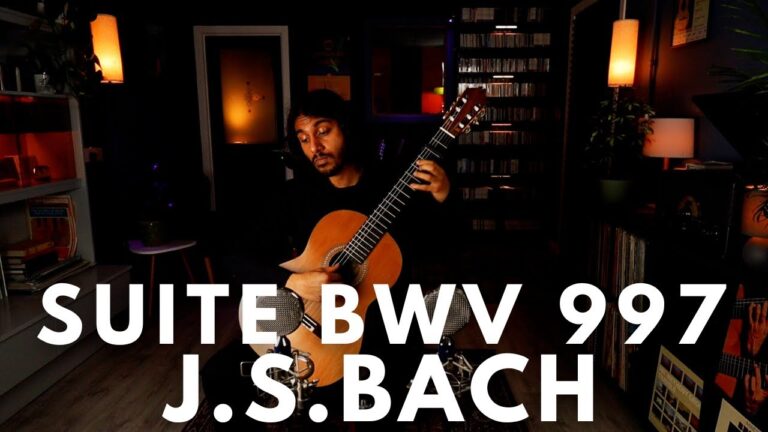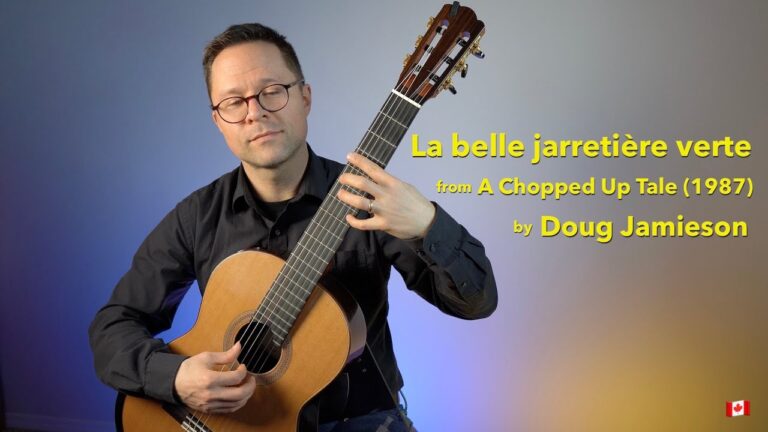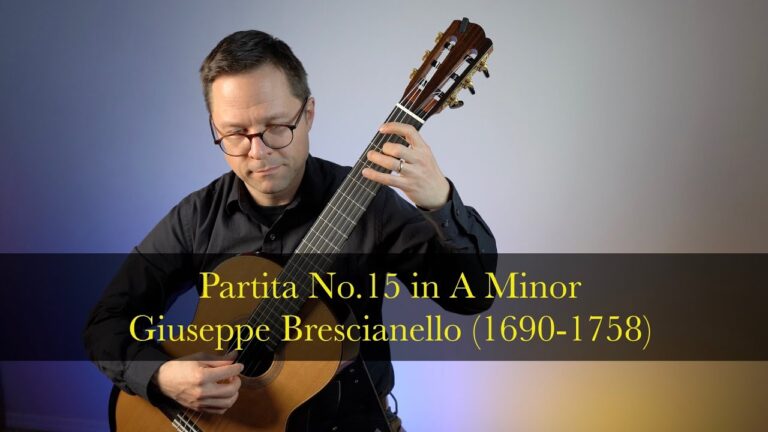This is a guest post by Clive Titmuss
Previously published on Classical Guitar Canada. Make sure to visit his website to see more of his work and recordings. All images provided by Clive Titmuss (click to enlarge). See image credits at end.
The Vihuela: Part One

The Ideal Instrument for Guitarists Interested in Early Music?
I recently completed construction a set of four vihuelas, having made more than twenty over the last 25 years. After a series of concerts and speaking to the audience afterward I was surprised at the interest and questions I fielded from guitar players, rather than the usual early music lovers or lute players. This has been a consistent reaction and it suggested to me that the vihuela is an instrument which is ideal for the guitarist who is attracted to the Renaissance literature, but may have reservations about the complications of the lute. You may explore the rich Spanish vihuela literature and the wealth of Italian or Elizabethan six-course lute music because it has the same tuning. In some respects, such as ease of playing in higher positions, the simplicity of unison bass courses and its tuning ergonomics, it is considerably easier to deal with than the lute.
I thought it might be interesting for readers to be introduced to the literature, surviving instruments and sources, to read a something of the history of its rediscovery and a discussion of the ways in which the music may be played on the modern guitar. I will talk about some of the ideas behind vihuela compositions and their main sources. Finally, I discuss how it might feel for the player of the modern guitar to play a period instrument.
Is it a Guitar?
The vihuela is a guitar cognate, but the tuning, technique of playing, texture and forms of its music and the repertory of pieces associate it with the lute. Closer examination of the vihuela books clarifies this. The vihuela was not the instrument which would later evolve into the guitar; the latter was considered another instrument entirely and two of the vihuela books make this clear. The Tres Libros de musica en Cifras para Vihuela, 1546 by Alonso Mudarra includes four fantasias, a pavane and three variations on the Romanesca bass dance in a separate section of music for four-course guitar.
The preface of the large collection of music compiled and composed by Miguel Fuenllana (Orphenica Lyra, Orpheus’ Lyre), some of the first intabulated music for the guitar, contains this telling remark: “…musica compuesta y fantasias para vihuela de quattro ordenes, que dizen guitarra” ([The sixth book contains]…”music and fantasias composed for the vihuela with four courses, which we call the guitar”). This is an indication that from the viewpoint of the vihuelistas, the guitar was a separate tradition. We have the impression that Mudarra and Fuenllana were deliberately raising the standard of the guitar’s music in their publications—to the level of the vihuela.
Whatever the shape or construction of the instrument itself, its literature is the result of a clash of ethnicities: The urbanized Moorish colonial regime, with its philosophy, mathematics and its celebration of geometric ornament was gradually displaced by the Latin-agrarian population of southern Spain. Culturally, the Arabic world was associated with the lute (al’oud). No wonder then, that during the post-Crusade period the Catholic monarchy and religious establishment preferred the vihuela. Going further back into the past, the relationship between lute, vihuela and guitar is much less clear. Manuscript illuminations, painting, and carvings seem to indicate that the vihuela of the 1500’s evolved from a viol-like instrument of the 1200’s, when two kinds of vihuelas were played, one bowed and one plucked. They were essentially the same instrument.
The non-Iberian medieval guiterne was the ancestor of the four-course guitar. The name probably derives from a Northern European corruption of the Greek word cithara, a lyre, or small harp. Today, aside from designating a period instrument, the term vihuela refers to a type of guitar played in Central and South America. It may have inherited this name from colonial times. The Ecuadorian Saint Mariana de Jesus played the instrument now placed in the Iglesia de la Compania de Jesus in Quito, Ecuador, made around 1625. As recently as 1976 close examination revealed that it appears to be a surviving vihuela.
Centuries of Moorish architecture and Morisco (Christianized Moor) culture underlies the appearance of the vihuela. The best-known surviving vihuela, at the Jaquemart-Andre Museum in Paris, has mudejar inlays intended to suggest the reliquary, the jewelled vessel which contained remains of the Saints and martyrs of the Church. Almost every sizeable monastery or parish would have had several. Like the lute in Italy during the 1500’s, the vihuela was associated with the divine, the angelic.
The Style of Vihuela Music
The vihuela books of the mid-sixteenth century contain complex contrapuntal works combining the style of Catholic vocal music and the Italianate fantasia of the lute. An established tradition of composition existed in the minds of the vihuelistas, and this determined the content of the music. The present-day musician who plays the music of the vihuela on the guitar will find that there is a rarefied atmosphere of strict voice-leading and architectural development of motifs. This style is not far from the virtuoso variations and intabulations of lute music from the same period found in most Italian and Northern European sources, but with a characteristic Iberian sensibility. By comparison to lute music, vihuela music is often spare and rather stark. Fuenllana’s Fantasias, for example, are rhythmically sober and strict in their preservation of voice-leading, sometimes at the expense of the virtuoso excitement we hear in contemporary Italian compositions.
Even as the vihuela style declined, the guitar underwent a period of further development during the 16th and 17th Centuries. At the outset of the 1500’s it was a four-course alto-pitched instrument played in ensemble (called the “cuatro” in the 1600’s) in the open air, used for music of simple means. Eventually, it became an instrument of expressive solo music played indoors. Two important Spanish composers of music for five-course guitar in the second half of the 17th Century, Francisco Guerau (Poema Harmonico, 1694) and Gaspar Sanz (Instruccion…sobre la Guitarra Espanola, 1674) still bear the unmistakeable marks of the dichotomy mentioned by Fuenllana. Sanz’s music is deeply rooted in folk idioms and melodies—true guitar music; while Guerau’s book, published twenty years later, has many features which remind us of the intellectual style of the vihuela.
The Revival of Vihuela Music in the 20th Century
In 1927, musicologist Leo Schrade published the first complete transcription of a vihuela book, Luis Milan’s El Maestro of 1536. Awareness of the vihuela tradition among guitarists in Spain in the early twentieth century is notable. In his 1945 edition of a selection of twenty of Fernando Sor’s studies for the guitar, Andres Segovia made this cryptic remark: “La rica tradicion vihuelistica se fue adelgazando hasa no poseer, al prolongar su vida en la guitarra… (The rich traditions of the vihuelistas gradually diminished until they lost their vitality in the guitar world…). It seems Segovia, who frequently played the music of Milan, Mudarra, and Narvaez at the beginning of his recitals, felt that the force of their traditions had lost its immediacy, and he concluded that this is why we must look to the studies of Sor, Aguado and Tarrega to elevate the guitar’s technique and its repertoire.
Confusion about the organology of the vihuela extended well into the twentieth century: In 1949, the American scholar Willi Apel published a widely-read textbook, The Notation of Polyphonic Music which consistently referred to Spanish “lute” music tablatures, though the vihuela is named in a footnote. In 1955, the Spanish musicologist and guitarist Emilio Pujol published the landmark Hispanae Citharae Ars Viva (The Living Art of the Spanish Guitar, still in print), which combined clear modern printing and precise modern-style fingering for the guitar with the proper tuning of the vihuela. This anthology presented some of the best pieces of the vihuela repertoire on their own terms. Pujol’s scholarly approach in this collection paved the way for the adoption of performance practice of the 16th Century based on source material, rather that the performance traditions of the 19th Century.
Because of his pioneering efforts, several of the best-known pieces of Mudarra and Narvaez became much better known through performances, and this has led to a more complete understanding of the entire literature. Facsimile editions of the books were published in the 1980’s and 90’s and in 2003 facsimile images of the entire oeuvre became available on a single printable and searchable CD [Libros de Musica para Vihuela, (edited by G. Ariaga and C. Somoza)], sponsored in part by the Spanish government.
There are two keyboard sources of music which draw on the music of the vihuela: Obras de musica para harpa, tecla e vihuela, (1578, posthumous) by Antonio Cabezon and Libro de Cifra Nueva para tecla, harpa e vihuela, 1557 by Venegas de Henestrosa. These sources are not usually included in the vihuela repertory, but they furnish a more complete picture of the way in which the riches of the vihuela tradition influenced the organ music of the sixteenth century.
[There are two edited collections of vihuela music from these keyboard sources in French/English in the Tablature section on my website (earlymusicstudio.com) —five fantasias from Venegas’ book (the last is by Valderrabano), and keyboard music transcribed for two vihuelas or lutes by Cabezon, including a set of variations on Las Vacas for instruments a fourth apart. There is an arrangement of Valderrabano’s extraordinary Musica para discantar sobre un punto (Divisions on a Single Note [from Silva de Sirenas]) for two equal vihuelas. You may play any of these pieces on the guitar using vihuela tuning.]
The Vihuela: Part Two
The Sources of Vihuela Music
The vihuela books contain distinct genres of music: movements in the Italian chordal dance style, such as Pavanes or Galliards; variation forms with repeating bass lines, related to dance style; Fantasia-style; in which vocal and instrumental style may blend; and the intabulation of pre-composed vocal music in three or four parts. Today’s players are more interested in playing Fantasias and variation-forms derived from dances, but it is the intabulation-forms which were regarded by musicians of the mid-1500’s as the summit of their art. This type of composition easily outnumbers any other type in the whole vihuela literature.
The largest source of vihuela intabulations is Miguel Fuenllana’s six books of Ophenica Lyra, 1554. His motet and Mass-movement intablulations of Juan Vasquez are masterpieces of the genre. The book employed a printing technique called ‘rubrication’, in which the cantus firmus (the plain song melody, or the vocal part) was indicated in the tablature in red. These intabulations sound well on the original instrument. The short duration and high partials resulting from lighter construction bring out the voices clearly. Although it is not unidiomatic, it is one of the most difficult kinds of music to play effectively because it makes little allowance for the player’s fingers, and places great responsibility on the inner ear.
Fuenllana seems to have been reticent to apply the art of discantar, the use of small note values to decorate underlying melodic material, in his numerous Fantasias. His works of this type are more abstract than those of his contemporaries, but no less rewarding for the player.
The earliest of the vihuela books is Luis Milan’s El Maestro, 1536 and it works well as an introduction to the repertoire. Milan organized the book roughly according to difficulty, with easier Fantasias at the beginning of the first book. Six Pavanes show strong ties to Italy and contain a microcosm of the vihuela vocabulary. The challenging and more technically demanding Fantasias, with their mix of consonances e redobles (chords and divisions) are found in the subsequent section. In the second book, Milan shows that he was a courtier above all, with secular songs in Italian and Castellano.
Luys de Narvaez (Los seys Libros del Delphin de musica de cifras para taner vihuela, 1538) is one of the most original vihuela composers. His variations are wide-ranging and his style more up-to-date than Milan or Fuenllana. The Flemish master, Josquin des Pres and Italian lute models give his music an international quality not found in the other books.
Alonso Mudarra offers some simple Fantasias for instructional purposes, and his variations are challenging, exploring unusual voicing and positions. The more demanding Fantasias require a highly developed right and left hand technique. He is one of first composers to offer advice about right-hand fingering, annotating his score with dedillo (alternation of thumb and forefinger in the lute style) and dos dedos (two fingers).
Enriquez de Valderrabano’s Silva de Sirenas (The Forest of the Sirens, 1547) is organized according to types and difficulty, and has pieces which are intended for two vihuelas of differing pitches. A few of his pieces were reproduced without attribution in Venegas de Henestrosa’s organ tablature of 1557. Valderrabano’s music is today not as well-known as it should be compared to the previous three masters.
The books by Diego Pisador (1552) and Esteban Daza (1576) show a decline in quality from the heights established by earlier masters, as the vihuela ceded its central position to other domestic instruments, the developing guitar, keyboard instruments and the violin/viol family. Their books deserve examination, if only to widen the player’s familiarity with the style.
The decline of the vihuela’s primacy in musical life may also be attributed to shifts in the social conditions in Spain. The gold and silver looted from the Americas destabilized the economy, there were military defeats at the hands of the British, and domination of the Netherlands proved costly. The church’s grip on the Spanish crown and military began to loosen, and some of the supports that contributed to the vihuela’s commanding position shifted.
Playing Vihuela Music on the Guitar
The modern guitar is a very different instrument from the vihuela. It is much easier to suggest the atmosphere of its music transcribed for the guitar than that of the baroque lute, for example. The modern player should distinguish the elements of the vihuela style. Without the support of the melodic and harmonic resources of the nineteenth and twentieth centuries, the performer of vihuela music must rely on attention to details, security of rhythm and accurate but flexible subdivision, and colour changes–which the guitar provides naturally. The right-hand technique of the original is worth imitating because it will produce a speaking non-legato, rather than singing, articulation. As late as the early 19th Century, Fernando Sor still advocated the alternation of thumb and index finger for scales and repeated notes.
Out of the entire repertoire of music for vihuela, the Fantasia-style pieces of Milan, Mudarra and Narvaez are those most frequently played on the guitar. The free-voiced style is more akin to the later music of the lute, and it explores the registers of the modern guitar to advantage. By comparison, the fantasia-style pieces can sound dull. This is probably an acoustical effect of the lower pitch more than musical content. Many players are not comfortable subtle shifts of tempo, rhythm and accentuation which are the basis of the rhetorical delivery that make the pieces effective.
Modern audiences have difficulty following the cantus firmus style; they have no cultural frame of reference for it. Despite these impediments, players should familiarize themselves with some of the pieces in this style, as many of them are rewarding to play and to hear. Their presence is always felt in the more virtuosic movements, and careful programming may help.
Here is an illustration of the way that an understanding of the sources might influence the performance of the repertoire:
One of the most famous of the vihuela pieces, Fantasia que contraheze la harpa en la manera de Ludovico (Fantasy which imitates the harp in the manner of Ludovico) by Alonso Mudarra, is often played on the modern guitar. The thematic material of this Fantasia has rapid running passages in ricercar style that alternate with broken chords. Most modern transcriptions have the player using fingering in which the over ringing of the stepwise notes on two or three strings is supposed to suggest the harp. It is my feeling that it is the broken chord figurations, and the bold dissonances of the second half, not the running passages, which imitate the harp. The intent is to contrast the texture and articulation of (staccato) rapid notes and (legato) open chords. This effect is more accurately presented if the interpreter simply plays the tablature.
It is common for guitarists to perform sequences of chords slightly arpeggiated, a legitimate practice for varying chord articulation in post- 18th Century music. In vihuela music, the consonances (chords) of two or three tones should not be arpeggiated; it will blur the counterpoint. Chords of three, four or more tones may occasionally be rendered by playing two notes with the thumb or index fingers rather than using the ring finger. This is another technique common until Sor’s time. The rapid running passages of Narvaez and Milan were played with thumb and index, in imitation of picking technique. This technique is easily performed on the guitar, but it is challenging to master the fluctuations of tempo and articulation which are a hallmark of the style.
The modern player should learn to read vihuela pieces from the original tablature. Learning Italian tablature, which mirrors the instrument in playing position, is not hard to read. The “upright” tablature of Luis Milan is virtually identical to modern number tablature. To play directly from tablatures for the vihuela, tune your guitar with the third string to f#, and place a capo on the second fret, rather than the third, and you will have the tenth fret at the neck/body joint, as with the vihuela. This is very useful when playing the more ambitious music of Milan and Mudarra, as it gives the eye and hand a more easily comprehended frame of reference. By using the capo d’astro it is possible to play music intended for two or more vihuelas on one size of guitar.
What is it like to play the vihuela?
In Part One, I suggested that guitarists interested in early music would have little difficulty adjusting to the vihuela. The adjustments are mainly psychological and aural, rather than technical. Once the player has altered the hand position slightly to account for plucking both strings of the course, the remaining challenge is to accustom the inner ear to hear the counterpoint and emphasize its linear character. Guitarists who handle and play a period guitar for the first time are often struck by how easily they work.
Modern guitars have evolved to having high-tension strings and fixed metal frets. Period instruments have less than a third of the string tension. The tied frets allow for un-equal temperament—playing chords that are better in tune, that is whose thirds do not beat rapidly, as in equal-tempered tuning. The double-stringing of the vihuela, baroque and later six-course guitars renders single notes that have a haunting other-wordly timbre, so vibrato is not required to make them sing. It may be used occasionally as an ornament. Most period guitars and lutes have a single top string, like the lute, in order to make melodic passages clear and to facilitate ornaments.
With a sympathetic technique, considerably less physical effort is required to play the same music. This takes some time to become accustomed, since there is little resistance to the plucking motion. The lower tension makes the profuse ornamentation much easier to perform cleanly. The sources do not necessarily include these ornaments, but we know from contemporary tutors and keyboard sources that they were common.
One may play both period and modern instruments in succession without difficulty, even in concert and plenty of performers do this. Many present-day vihuela players use their nails and do not play the lute, which requires a specific, more stringently documented technique. It is worth remembering that in most of the world, a reference to playing ‘ancient’ ‘classical’ or ‘period’ instruments or music would result in puzzlement. I once attended an Indian Classical Music class in which the instructor used the phrase “Recently, in the twelfth century…” It is not an exaggeration to say that we all play “period” instruments.
Though recognition of the historical importance of early Spanish music and of the vihuela began in the early 20th Century, the impulse to play the music on a period instrument has taken much longer to develop. Attempts by various guitar makers in the early years of vihuela revival to make instruments more along the lines of modern guitars resulted in hybrids that were dull-sounding and quiet compared to the lively response of recent, more faithful copies. In effect, lutherie had to catch up with the pace set by historians and the demands of performing musicians. As makers began to employ evidence of vihuela construction gleaned from the few surviving instruments and details taken from pictorial sources, it became clear that the care and attention lavished on the vihuela literature by its greatest exponents was justified by the merits of the instrument itself.
Photos are of instruments built by Clive Titmuss. Click to enlarge images.
The Vihuela—Part III: Confessions of a Vihuelista
First Encounter
“A quaint and curious volume of forgotten lore…” That famous line from Poe’s “The Raven” popped into my head while at a sale of books no longer wanted at the University of Calgary’s music library book sale. “Music from the Court of Carlos V”…subtitled “Libro de Venegas”. The binding creaked, dust motes floated in the June sun, the pages were thick and a warm yellow at the edges. Had anyone ever opened this book? Picking up the volume, and flipping through, it appeared to be a large collection of keyboard music in staff notation, with a long study of the music in Spanish.
A reproduction of one of the original pages caught the eye–the neck and body of a vihuela, in woodcut, with note names written on the frets. This book was duly purchased for three dollars in 1976, and it was the beginning of a long journey, a discovery of the vihuela and its literature. It turned out to be a complete transcription of a monument of the Spanish music of the Renaissance period: “Libro de Cifra Nueva para Tecla, Harpa y Vihuela” composed and collected by Venegas de Henestrosa, organist to Carlos, from 1557, laboriously transcribed by Higinio Anglés, an important Spanish musicologist, in 1944. This book is still not usually grouped with vihuela sources in tablature, though it is an important source of information about the atmosphere and culture of the vihuela–an exceedingly rare commodity after 450 years.
A few years later, I first played a vihuela while a post-graduate student of the lute in Switzerland. It was a rather crude thing made by a Swedish guitar maker, owned a visiting student who had come to town for a few lessons. The lutenists played their work in a class every week, and after I had performed my suite of 17th century French music, he pulled out a curious instrument, we gathered around and everyone tried it. It had a strange, hybrid shape, lute bridge, twelve pegs, tied frets like the lute, and fairly thick overspun metal strings like a guitar in the bass.
At the time not every builder was convinced that lighter construction would result in a better instrument, and this vihuela had construction features from both camps— details that were lute-like, but a structure that was heavy and guitar-like. It sounded rather subdued on the upper strings, but it had a good bass. A desire to play the music on something like this, rather than the lute, immediately seized me.
In the second year of my studies there, I met an Australian player who used to carry three vihuelas of different sizes around in a huge flat box. Well, he was a little odd. Each of them was made of exotic Australian woods and they were instruments that were more successful. With a “chest” of vihuelas of different pitches, he could play with recorders and viols in ensemble and still be heard. It was a solution borrowed from the past, a vihuela for every occasion. When the ensemble needed bass, or an obbligato to accompany the voice, there was a tool for the job that had something to add to the band.
Building a Vihuela inspired by Luis Milan
My first attempt to build vihuelas was about five years later, when a student gave me a large chunk of yellow cedar. Cypress is the timber usually used for flamenco guitars, and yellow cedar, despite the name, is a cypress which grows in British Columbia. At first glance it looked straight and very close grained to be good for the soundboard; many harpsichords of the 17th Century were made from cypress. Encouraged by Michael Dunn, who liked it for tops on his Maccaferri guitars, here was a great material for the back and sides. Dunn recounted how he used the bottom step of his basement stairs, beautiful old-growth Douglas fir, for a lute soundboard. That spirit of using what is around you seemed right.
The yellow cedar planed and finished wonderfully and like all the members of its family, it had a fragrance better than food or perfume. The mould was taken from Milan’s picture of Apollo (“The first vihuela player in the world”). When it came to the barring, there was no model; and at that time, there was very little information about the interior construction of the vihuela. After consulting with a luthier John Rollins in Bellingham, a simplified lute-style ladder barring seemed to be right, with a couple of long fan bars behind the bridge. And it sounded pretty good, if a little short of breath. I remember being terrified to cut into the soundboard to inlay the parquet tiles. I played it for a few years and gave many concerts with it—it was very sweet-sounding. Guitar Nuts at performances were always asking about it.
It was played at a gallery opening in White Rock for the first time in public, and it ended up in an exhibit with a baroque guitar and a few lutes at the Fraser Valley College. Instruments on pedestals with Plexiglas covers induced a strange feeling of separation. They even exhibited the cases. This early vihuela was used for a complicated concert program which I did several times in the Vancouver area and in Victoria, in which I played four of my instruments, with music by Milan, Narvaez, De Visee, with music by Weiss and Bach on the baroque lute. It’s a challenge to juggle many instruments in a concert—a lot of tuning and management of difficult repertoire on instruments that are very different from one another in the way they feel.
Eventually, the first vihuela was purchased by a collector in White Rock. When she died, she donated her collection to the White Rock Museum, housed in the old Burlington Northern Railway station near the pier. This closed a circle—this heritage building was the location of my first performances in BC, where I used to play concerts and have the student recitals. The entire 50 metre long building had been moved back ten metres and converted to a museum. When I played there, you had to stop when the train went by at around 9 pm, make a joke about the modern world, and go back to your pieces.
A Second and Third Try: Basic Ideas are Refined, New Information is Incorporated
The first vihuela, though a success in many respects, had some problems: Too large, too quiet, back too flat, too many bars. On the second try, I made the instrument smaller and used soundboard material from a 200 year old piano (far left in photo). Using a sharp plane on the wood was very odd, because when spruce gets that old it is prone to “brash failure”, which is lutherie jargon for “cardboard”—particulate and crumbly. I suspected that it would never work. Surprisingly, it sounded incredible, with a ring that seduced the ear. I’ve since heard of several makers of harpsichords who go around searching for old timber for soundboards and braces to get just this ringing quality.
This vihuela had fewer little bars and the top was thicker. I made four in that series and every one was different: soundboard material, barring, bridge position. It was the first time I tried producing a number of instruments at once, and the opportunity to experiment is one of the reasons to work in that way. The experiment also resulted in the realization that guitars may easily be produced in small-scale production by a single artisan, but the lute is a carving, and does not lend itself either to decoration, repeatable operations or parts-bin manufacture. Vihuelas are simple, and once the tiles and the design are fixed, there are infinite variations.
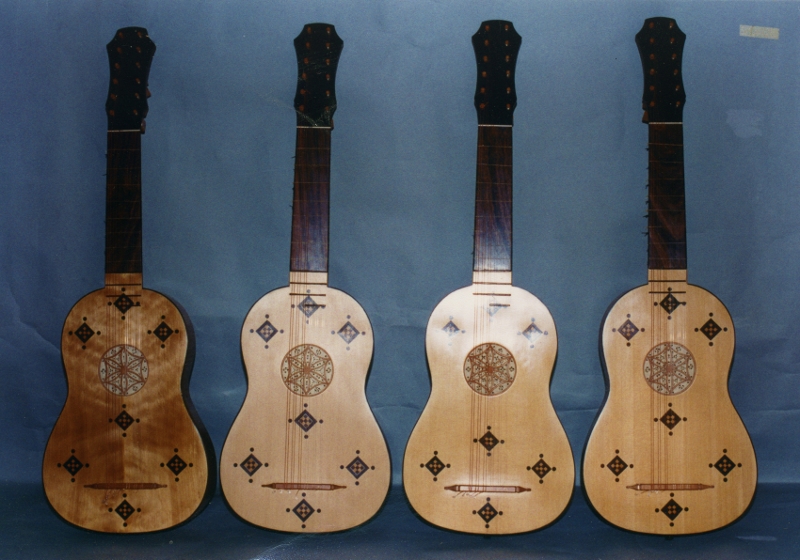
A number of these vihuelas were made with another cypress timber, Port Orford (Oregon) “cedar”. It is a unique timber, with a straight grain, resinous, and an explosive pluck. The Early Music Studio collection includes an Italian-style harpsichord with both case and soundboard made from Port Orford. The vihuelas were made using pieces from that construction.
The piano-spruce vihuela was bought by a collector in Vermont. He had a number of them, including some heavily-built guitar-like instruments by the Vera brothers in Spain dating from the sixties. They were very handsome instruments meant to make a guitarist feel at home, with string tension close to a modern guitar, a saddle bridge, metal frets and (I think?) tuning machines instead of pegs. Their instruments had appeared on a few early recordings. He sounded disappointed that they didn’t work better, and perhaps this is a matter of expectations. They did look wonderful.
For the third run, I made the instrument more closely resembling a smaller Jaquemart-Andre vihuela, drawn using only circles, no ellipses. This piece of information came from Jose Romanillos, who compiled a lot of research into early Spanish lutherie going back to the 16th century. The point is history in which the circle was replaced by the ellipse in art and architecture is one of the markers of the early Baroque wind of change. The Quito and Chambure vihuelas (see Part I) show evidence of this feature. The modern guitar has almost no true circularity, the shape is all based on two foci. The true vihuela is a pre-Baroque construction, and the bridge sits at the centre of the circle, reflecting an entire cosmology.
This third design for the instrument proved to be a bit too small for me, though I greatly refined the making of tiles and inlay while constructing it. Just when you think you may have made a mistake, someone else thinks it is perfect. A woman with small hands who had some difficulty playing the guitar just loved it.
Fourth Time Lucky
Finally, with the fourth mould, a new simpler barring, and a vaulted back, the most recent design has achieved the same kind of quickness of response one gets from playing the lute. It will accept a vigorous playing and it therefore has a wider dynamic range–much better than previous instruments. Part of this had to do with widening the neck and bridge so that the strings are farther apart. Each iteration of the vihuela benefitted from a thicker soundboard and a stiffer area around the rose. Only two bars are place above and below the it, but more widely spaced than modern instruments. They are very tall, with no carving of the ends to fit a mortise in the lining. Why bother, one may as well make the instrument really stiff, but light. This idea came from none other that Antonio Torres; it appears have been a constant feature in Iberian lutherie for centuries. Some baroque guitars, those of the Voboam family for example, had very tall bars, In period guitars there is no kerfed lining as with modern guitars, only little blocks (tentelones) to position the top, and pieces of linen soaked with glue to fix the bars to the sides, and the top to the carcase. Some of the earliest extant instruments employ this technique, and it results in a much lighter guitar, with a top that is free to vibrate. I also discovered, quite by accident, that is, the hard way, that cloth linings prevent buzzing, which can drive the player mad in minutes.
A Collaboration Reveals New Riches
The most recent vihuela encounter resulted from collaboration with long-time friend and colleague Alan Rinehart. After knowing one another for decades, we finally moved to the same city and wanted to get together and make some music. I built two matching vihuelas (from a run of four), and it seemed that it would be a great opportunity to arrange some music by Antonio de Cabezon, one of the greatest geniuses of the 1500’s: It had been a long time ambition. His book mentions the vihuela in the title. It is clearly music written for the organ, with many ideas taken from his vihuela-playing contemporaries.
His variations on Guardame Las Vacas, a cover tune, are a tour de force of compositional virtuosity. We worked on that piece and a few others, the Caballero, and the Gaillarda Milanesa, along with the Spagna bass dance. We spent a lot of time making the arrangements and getting the duos working so that there were no extra notes. This was a really rewarding experience, time spent with an old friend, and the luxury of time to shape the music exactly as you wish.
We called the concert The Two Man Guitar Festival and arranged a tour of interior British Columbia. There was Renaissance music in the first half and music for two six-course guitars in the second half. The six-course guitar music was relatively easy to arrange and play (we did some Sor duos and the Boccherini Fandango), but the vihuela music took the lion’s share of rehearsal. Anyone who has ever worked with another guitarist knows just how much time it takes to get those plucks together.
Facing the audience at last, it was no surprise that of all the music played in that program, the Cabezon pieces created the greatest hush among the listeners. They clap for Sor, he is a crowd pleaser, but they are really quiet for early music, they respond in a very special way, to style which has few notes and very little in the way of fireworks. Everyone seems to understand when they are listening to a masterpiece.
Time to Make a Recording
After being convinced that I had an instrument that worked well, the time came to make a recording of some of the most interesting pieces. A well-equipped and technically sophisticated studio is located in the Okanagan, a short drive from my home. It is in the basement of a mansion overlooking a vineyard and Skaha Lake. I’ll never forget the impression of qui rising from the landscape itself as I played and looked out the window, through the frozen vines, down to the windswept lake, and the mountains beyond. It’s a moving experience just to be there.

The studio masterminded by Stu Goldberg. He is a pianist, composer, arranger, film scoring genius and one of the best producers of recorded music in the country. He moved here from L. A., where he cut his teeth working in the movie industry. He was delighted to help with the vihuela recording.
Normally in recordings that I have previously made, there is a certain amount of air between instrument and mike, but Stu suggested that we try one of his most sensitive German tube-driven transducers. I play the instrument against a table, which serves to amplify, stabilize and prevent noisy movement. Making recordings with the lute, this set-up had worked well. The light construction of early instruments tends to amplify string and finger noises. Using filters it is possible to remove most of the string and plucking noises which occur at predictable frequencies. The result was novel, since usually the instrument is only heard from the player’s point of listening. People who listen to music often have no idea how much of the signal is not really musical and what must be done to achieve an acoustically clean result. I have never made a recording in which the sound of the finger plucking the string is more faithfully reproduced than this one. After we recorded the pieces we edited and mastered them, everything complete in one marathon session of nearly ten hours.
My reservations about the starkness of vihuela writing were unfounded; the recording filled the ear wonderfully. Stu had some technical wizardry at his disposal: a couple of sound-engineers from Holland had set up mikes in various positions in famous churches in Holland and made software algorithms which could be used to process the signal. So we decided to virtually place the vihuela in a church in Holland, with the mikes close and far, mixed together. The result is one of the most polished and refined sounding recordings in my experience. Of all the music which I have in streaming digital distribution, this is by far the most frequently streamed. While I was making the recording, I had the strong impression that is would never be heard!
The Vihuelista Waxes Philosophical
There is still so much about the culture of the vihuela, the instrument and music, which we don’t and probably never will understand. The decorative aspect of the vihuela is one of its most attractive features, as it is with the five-course guitars of 17th Century Italy. The the instrument’s internal workings are obscure. This may be due in part to our expectations of the music. It was a very private and internal dialogue between musician and instrument, and the composer-players of the sixteenth century didn’t really leave us many clues about the way that the instrument was played. There are plenty of lute tutors, and they examine every aspect of the music, but for the vihuela’s performance practice, its context and organology there is only a remnant.
The difficulty of comprehending the deep structure of the vihuela repertoire is one thing, but the situation is even more mysterious with the structure and manufacture of the instruments. How shall we conclude anything based on three instruments, each of which has features that seem to make it unrepresentative?
Today’s musician must play the music over a number of years and in performance to best gauge its effects and understand how it is heard by the contemporary listener. The iconography–pictures, carvings and intarsia indicate that the vihuela had a devotional aspect manifest in its literature. This is far from the secularization movement of humanist lute music. The vihuela repertoire presents a quality that is remote from our distracted psyche. Perhaps no amount of musicology or introspection will bridge this gulf.
At first there was scepticism that trying to make copies of instrument from the past would yield a vihuela that would do the music justice. It turned out that the really crucial information would be found, not in the search for a viable instrument to copy, as was the case with the lute, but in finding answers in the music itself. When you play the music, you find that your instrument will tell you how it should be played. That process may take much longer than simply looking at a plan, making a mould and starting construction of an instrument whose properties are predictable. First, there has to be an idea about the basic aims that the instrument and player are trying to achieve.
I found at the beginning that though I was gaining greater control over the decoration, the joinery and the process of construction, I still had far to go with finding a model that would attenuate the string energy. I had to experiment with size, shape, thicknesses, materials, stringing and barring, for a long time before there was a benchmark. Once there was a good instrument to play, it took more time to understand the underlying ideas of vihuela music as a whole, and to see how that stylistic perception would translate directly into musical decision-making.
At one time my initial reaction to Luis Milan was rather cool; it seemed less interesting than Mudarra or Narvaez. That proved to be a misjudgement, and I now see that even his simple pieces are brilliant masterworks. The last few fantasias of El Maestro are some of the best music ever written for a plucked instrument: His sequences of consonaces et redobles are like the arches of enormous cathedrals on a small scale. Likewise, the fantasias of Fuenllana left me unimpressed at first, but when I got around to playing them on a decent instrument, they awakened a reverence for the sober catholicity of his counterpoint. Of the composers who left tablatures for the vihuela, perhaps Fuenllana is the key to the inner world of the vihuela.
When you play a good one, and I did not for at least twenty years after I saw the first Swedish Panzer-vihuela, I realize why the vihuela players lavished such great care and attention on their music. It is the instrument itself which stimulates the player, but it is the mysteries of the music which most inspire.
Clive Titmuss, Kelowna, BC
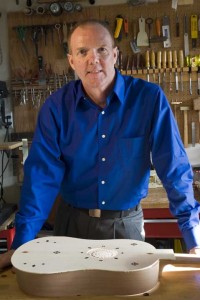
This was a guest post by Clive Titmuss
Again, a big thank you to Clive for this epic article. Make sure to visit his website to see more of his work and recordings (earlymusicstudio.com).
Photo Credits:
- Jaquemart-Andre vihuela photo C. Gonzalez, from La Guitarra Espanola, catalogue of an exhibit, 1993, Museo Municipal Madrid, The Metropolitan Museum of Art.
- The Quito vihuela: photo David Huxley, Iglesia de Compania de Jesus, Quito, Ecuador.
- The Chambure vihuela photo was taken from the Cite de Musique website-http://www.citedelamusique.fr/anglais/
- The vihuela angel: http://en.wikipedia.org/wiki/
File:Vihuela-angel-G_Iberia_ 16th.jpg
Extra: Clive Titmuss and improvised elements in early Italian lute pieces





